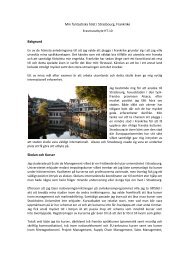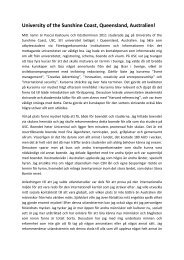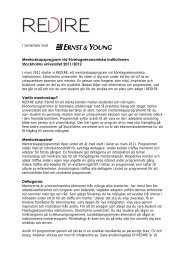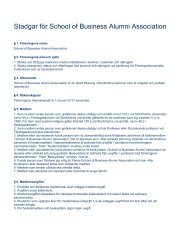Download full programme and abstract book pdf 1.6
Download full programme and abstract book pdf 1.6
Download full programme and abstract book pdf 1.6
Create successful ePaper yourself
Turn your PDF publications into a flip-book with our unique Google optimized e-Paper software.
02:11<br />
Cognitive distortion accounted workload in service operations<br />
von Scheele, Fabian; Haftor, Darek M.<br />
Stockholm University School of Business, Stockholm, Sweden<br />
Abstract Compared to the production of goods, service<br />
operations are typically more workforce intensive <strong>and</strong> use one<br />
of two very different kinds of contracts: current account or<br />
fixed price. This implies that the workload <strong>and</strong> the working<br />
time of human agents that produce services are central for<br />
the efficiency <strong>and</strong> quality of service operations <strong>and</strong> service<br />
economy. The present elaboration proposes a novel workload<br />
equation, of human agents executing service operations.<br />
This workload equation incorporates the phenomena of<br />
cognitive time distortion, which is the difference between the<br />
physical time <strong>and</strong> the cognitive time for a given spatial event;<br />
the primer is measured by means of a physical clock while<br />
the latter is assessed by the human psyche. The proposed<br />
workload equation states that with a fixed relation between<br />
profit level <strong>and</strong> price, time distortion of the total contracted<br />
time is inversely proportional to the distortion of profit.<br />
This implies that variations in price <strong>and</strong> workload can be<br />
interpreted as the result of cognitive time distortion. This<br />
shows that the cognitive time distortion has a pronounced<br />
lever effect influencing price, profit <strong>and</strong> workload. Small errors<br />
in time assessment, made by the human agents engaged, may<br />
correspond to dramatic variations in price, profit or workload.<br />
The significance of the proposed workload equation is that, for<br />
the first time, the phenomena of cognitive time distortion, well<br />
known in the mental <strong>and</strong> medical sciences, is now incorporated<br />
into an economic conception of human activity systems, such<br />
as service operations. This, in turn, opens an opportunity<br />
for the development of managerial techniques that may help<br />
us to detect, predict <strong>and</strong> reduce the emergence of cognitive<br />
time distortion, <strong>and</strong> thus its consequences, such as human<br />
work overload, the human not well being, <strong>and</strong> the economic<br />
inefficiencies.<br />
02:12<br />
How is service innovation organized in KIBS-firms? - Towards a<br />
typology of service innovation practices<br />
Hallin, Anette<br />
KTH: The Royal Institute of Technology, INDEK: Dept of<br />
Industrial Economics <strong>and</strong> Management, Stockholm, Sweden<br />
During the past decade, a rapid increase in scholarly research<br />
on new service development (NSD) can be identified. Despite<br />
recent contributions, NSD remains among the least studied<br />
topics in the services management <strong>and</strong> innovation literature. So<br />
far most attention has been given to the success factors in NSD,<br />
<strong>and</strong> the majority of empirical studies have addressed relatively<br />
st<strong>and</strong>ardised consumer services such as financial services.<br />
Furthermore, much of the traditional NSD research principally<br />
tests the application <strong>and</strong> applicability of models for the product<br />
development process in the services context, <strong>and</strong> fewer attempts<br />
have been made to describe the versatile approaches that are<br />
actually practiced in service firms. In sum, little is known about<br />
how professional service companies in particular organize their<br />
daily activities in order to develop services for business-clients.<br />
The purpose of this paper is thus to explore how NSD/service<br />
innovation is organized in KIBS-firms. This is achieved though<br />
qualitative, multiple case studies investigating knowledgeintensive<br />
business service firms in Sweden <strong>and</strong> in Finl<strong>and</strong>.<br />
By comparing service development practices across cases the<br />
paper seeks to identify different approaches for organising<br />
service innovation in KIBS firms. The outcome of the paper<br />
is a typology of service innovation practices where service<br />
innovation is understood as a result of organizational features<br />
such as organizational size <strong>and</strong> type of formal structure, as well<br />
as of service features such as degree of st<strong>and</strong>ardization <strong>and</strong><br />
tangibility of the service.<br />
Whist the service literature suggests different marketing <strong>and</strong><br />
management implications for different types of services,<br />
the nature of the service offering, or the features of the<br />
service organisation are seldom addressed as contingencies<br />
for service innovation practices. The study contributes to<br />
the literature domains of service innovation <strong>and</strong> NSD by<br />
increasing underst<strong>and</strong>ing on the context dependency of service<br />
development practices.<br />
02:13<br />
A research model for sales force strategy the during product<br />
launch<br />
Haftor, Darek; Fraenkel, Stefan<br />
Stockholm University, School of Business, Stockholm, Sweden<br />
The current call for, <strong>and</strong> focus on, innovation of new products,<br />
services <strong>and</strong> capabilities have a twin side: once a new product<br />
has been developed it needs to be introduced onto its targeted<br />
market. In many industries, a key tool for such a product<br />
launch is the company’s sales force. The latter’s configuration<br />
<strong>and</strong> management may determine success or failure of a<br />
product launch <strong>and</strong> in some specific cases the future existence<br />
of the whole company. Further, in several industries, e.g. the<br />
pharmaceutical, the sales force frequently generates the single<br />
largest operating cost. Given this dual strategic position of<br />
a sales force, a determinant for successful revenue streams<br />
<strong>and</strong> a key operating cost when launching a new product, it<br />
is unfortunate that there is very little research produced with<br />
regard to what constitutes the key success factors for a sales<br />
force strategy during the launch of a product – this is the<br />
concern of the present inquiry. By means of an exhaustive<br />
literature research the available empirical research results have<br />
been identified, including sales force strategies <strong>and</strong> new product<br />
launch strategies. Further, by means of conceptual elaboration,<br />
a novel model has been formulated based in the identified<br />
previous research results. The proposed model is constitutes of<br />
three kinds of categories: (a) the constructs that characterize<br />
the market conditions for a product launch, (b) constructs that<br />
account for the sales force configuration, <strong>and</strong> (c) the constructs<br />
for a product launch performance. The aim of the proposed<br />
model is to guide the design of empirical research into what<br />
constitutes key success factors of a sales force strategy during<br />
a product launch. The next step would therefore be to design<br />
such empirical research which will most likely requires some<br />
adaptations of the proposed research model to the industries<br />
<strong>and</strong> markets addressed. The novelty of the proposed research<br />
model steams from the synthesis of sales force management<br />
models <strong>and</strong> product launch models.<br />
02:14<br />
Service selling in industrial organizations: An exploratory study<br />
of challenges <strong>and</strong> opportunities<br />
Kindström, Daniel 1 ; Carlborg, Per 1 ; Nordin, Fredrik 2 ;<br />
Kowalkowski, Christian 1<br />
1 Linköpings universitet, Institutionen för ekonomisk och<br />
industriell utveckling, Linköping, Sweden; 2 Stockholms<br />
universitet, Stockholm, Sweden<br />
An extension of the offering of industrial firms with services<br />
implies that several elements of their product based business<br />
models need to change to appropriate the promised benefits<br />
of such extension. One such important element is the sales<br />
function. Although much research focuses on the transition<br />
towards services, there is a void of in-depth studied of the<br />
effects <strong>and</strong> requirements on the sales function. This paper<br />
addresses this gap by exploring challenges <strong>and</strong> opportunities<br />
for the sales function in industrial firms when their offerings<br />
63

















